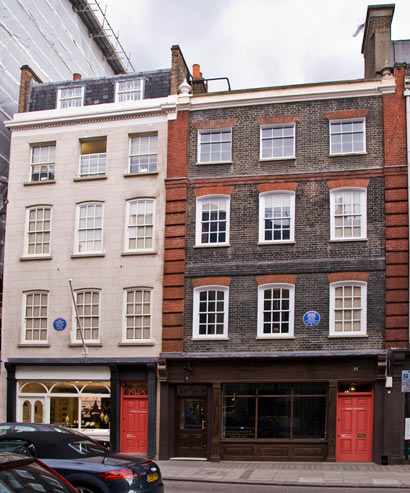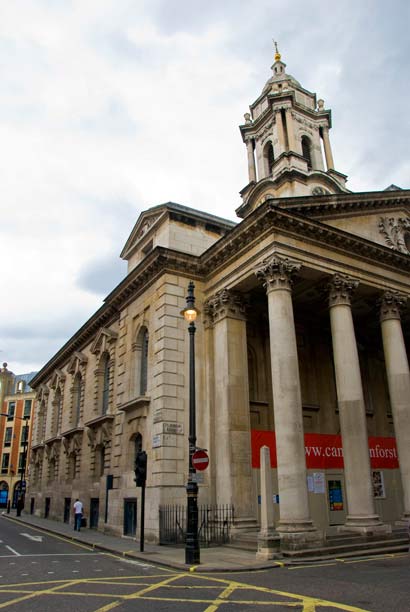
When brides request specific music for their wedding ceremony in the Hudson Valley they often choose the compositions of George Frideric Handel. So when Harmonious Music decided to take a trip to London it was thought that the voyage would not be complete without a visit to the Handel House Museum at 25 Brook Street. Anyone with an interest in music history should make a concerted effort to visit this wonderful treasure.
G. F. Handel moved into the home in 1723 shortly after his appointment as Composer to The Chapel Royal. Prior to this he had lived as a guest in the homes of some prominent Londoners after immigrating to England in 1712. The Chapel Royal Appointment and its hefty salary of £400 must have certainly made Handel feel secure enough to find a place of his own.
Handel’s Chapel Royal appointment and overall success in London was largely a result of England’s cultural inferiority complex. At the time many well to do Englishmen went on “Grand Tours” of continental Europe. They brought back artwork and an appreciation of contemporary music along with the belief that England’s artists did not compare to those from abroad. As a result foreign musicians and artisans were given access to greater opportunities in London than they could find on the mainland.
Handel moved into 25 Brook Street soon after it was built. It was constructed by George Barnes along with five other units. The Brook Street neighborhood near Hanover Square was a new hot spot for a growing upper middle class elite. Surprisingly, Handel did not purchase the home outright. Instead he opted to lease the property. This is likely because musicians and composers of the 18th century often needed to remain mobile so that they could move from opera house to opera house.
Visitors to the Handel House Museum are first ushered up to the third floor where they are treated to an informative film over-viewing Handel’s life and achievements. They are then free to wander the painstakingly restored residence starting with a wonderful hearth room, the museum calls the “London Room.” Handel would have used The London Room as a dressing room. You quickly notice the amazing wide plank flooring that appears as if Handel himself certainly must have traversed.
Visitors then meander into Handel’s bedroom complete with a period canopy bed. Although, none of the Handel’s original furniture remains, the Handel House Trust exhaustively researched the records of Handel’s estate to recreate the original appearance as closely as possible.
Nearby visitors find an exhibition room complete with a beautiful reproduction harpsichord. Signs indicate that visitors are forbidden to use it. But it certainly beckoned to our resident keyboard expert. The exhibition room also contained some original manuscripts behind glass. One of which was in the hand of Wolfgang Amedeus Mozart. A sign nearby explained that one of Mozart’s best clients, Baron Gottfried van Swietenwas, an admirer of Handel and requested that Mozart perform his work regularly. Mozart wrote of Handel:
Handel Knows best what produces effect. Where he wants it he strikes like a thunderbolt.
The Handel House Museum clearly made a great effort to make the exhibit interesting for children. There is a computer setup with a keyboard for guests to compose their own music. There are also period costumes sized for children of all ages to adorn. There are also “fun trails” throughout the museum and quizzes to help keep the kids interested in the museum.
Treading down the stairs from the third floor to the second, one quickly notices the amazing wood railings and paneling. The Handel House trust pealed back 28 layers of paint to determine the original appearance of the Georgian era home. A great deal of effort was needed in restoration in part due to the arrogance of CJ Charles who was an art dealer. He chose to turn the residence into a shop and greatly altered the former homes appearance including the removal of the Façade on the first and second floors. The Handel House Trust also holds a lease for neighboring 23 Brook Street, which was the residence of the 20th century musical genius Jimi Hendrix. 23 Brook Street managed to maintain its integrity from the Georgian Era and as a result was used as a model for the restoration of #25.
Because Handel never married and remained celibate for most of his life it is safe to say that the first floor of the home is where the action took place. It was here that Hadel received guests, held closed door rehearsals, and composed his masterpieces. He also used the first floor of his house to sell subscriptions to his performances and he also sold some of his published music there. Today the area is still used for modern performances of Handel’s Music on another reproduction harpsichord. However, the real treasures of the first floor are the authentic harpsichord from the period of Handel’s lifetime, along with a wonderful painting of Handel.
Handel was actually a serious art collector in his own right as were most of the elite from the Georgian Era. His estate listed hundreds of pieces and it is, believed that his walls would have been covered in artwork. Handel’s collection was auctioned off in 1760, but the contents of the auction sale catalog weren’t published until 1985. His art collection contained 64 engravings, which were reproductions of topographical views, landscapes and famous paintings. Another 87 pieces of Handel’s collection were paintings. Of those, almost half were landscapes. The rest of his art collection encompassed genre paintings, history paintings, erotica, and biblical histories. There were very few portraits documented in the auction, which leads authorities to believe that the collection may have been incomplete at the time of auction. This is due to the fact that portraits were the most popular form of painting during the Hanoverian period. Unfortunately we only know what happened to a handful of works from Handel’s collection because he did not label it in anyway. Because of this the Handel House Trust has adorned 25 Brook Street’s walls with portraits of Handel’s associates as well as prints that depict the major influences in Handel’s works.
The first floor of 25 Brook street is where Handel composed many of his masterpieces including the three operas Giulio Cesare, Tamerlano and Rodelinda. He also worked in the study to write Music for the Coronation of King George II including Zadok the Priest, which has been performed at every British Royal’s Coronation henceforth. Other manuscripts that poured out of 25 Brook Street’s study included Music for the Royal Fireworks and a slew of Oratorios. Handel is largely credited as being the original master of English Oratorio or in other words instrumental music with vocals set to religious text. Perhaps Handel’s most famous work written in 25 Brook Street’s study was the Oratorio Messiah.
Harmonious Music regularly performs portions of Water Music at weddings in The Hudson Valley. While wandering the halls of Handel’s personal study we could not shake the sense that Handel’s spirit was emanating from the walls around us and that this visit to his private residence would carry through in our performance of his work back in the United States. The following is a recording of Handel’s Hornpipe from Water Music arranged by Harmonious Music for Piano and Violin.
Handel actually wrote Water Music prior to his tenure on Brook Street. Yet the piece was certainly partly responsible for his ability to naturalize in England in 1727 along with his appointment to the Chapel Royal. King George I was so pleased with the inaugural performance of Water Music that he requested it be performed a second time in its entirety.
When Handel first immigrated to England he was largely known for his mastery of Italian Opera. The first floor of the Museum described in detail Handel’s sometimes turbulent relationships with his male Castrate tenors and the original Prima Donna performers. These star’s prominence did not diminish, even as London’s taste for Italian Opera began to move towards English Oratorio following John Gay’s masterpiece The Beggar’s Opera.
Handel is sometimes remembered for his fiery temperament. However, in order for him to maintain a leadership role with talent such as the diva sopranos Francesa Cuzzoni and Faustina Bordoni he would have needed a strong explosive will himself. A visit to the Handel House Museum enlightens the patron that many of Handel’s vocal pieces were written for specific performers, and that he needed to take the star performer’s vocal range into account during a work’s initial composition.
Towards the end of his life Handel began to lose his eyesight and thus became dependent on his copyist John C. Smith’s assistance in composition. To correct the problem with his vision Handel sought the expertise of oculist John Taylor. Interestingly Taylor was the same doctor who conducted eye surgery on J.S. Bach. The doctor’s hand left both composers completely blind. Handel survived for eight years following his botched surgery, but Bach was not so lucky.
Due to John Smith’s devotion to Handel in the composer’s twilight years he was bestowed over 100 volumes of Handel’s manuscripts. Smith in turn presented them to King George III and as a result they are still maintained by the British Library. King George III was one of Handel’s biggest fans, and it is safe to say that Handel’s continued popularity can be partially attributed to the King’s musical appreciation.
George Frideric Handel passed away on April 14, 1759. The lease of 25 Brook street was given to Handel’s servant John Du Burk. Records indicate that Du Burk subsequently turned the residence into a boarding house.

While at the Handel House we learned that the chapel that Handel attended regularly was located near by. So we decided to stroll over to Saint George’s Hanover Square and see the pipe organ that Handel likely performed on and perhaps even helped fund the creation of. Unfortunately the chapel was closed when we arrived. However a sign made it clear that the structure and organ inside were being extensively renovated. So it has been decided that a return trip to both the Handel House Museum and St. George’s Hanover Square is required.
The museum is well worth a visit for anyone with an appreciation of Baroque music or British history in general. As a musician who routinely performs the work of Handel in New York’s Hudson Valley, I can’t help but believe that I am more inspired to perform a heartfelt rendition of his works now that I’ve visited the master composer’s home.
Sources
Handel House Museum Companion
Jacqueline Riding
Early Music:
Handel as art collector: art, connoisseurshipand taste in Hanoverian Britain
Thomas McGeary
Bach And Handel (Their Influence On Future Composers)
Jeffrey Langlois
Musician’s and Music Lovers
William Foster Apthorp
Tags: #23 Brook Street, #25 Brook Street, 1723, 1759, art collector, artwork, Baroque, brides, Cesare Giulio, Chapel Royal, Composer, copiest, Coronation, England, Faustina Bordoni, Francesa Cuzzoni, G.F. Handel, George Frideric Handel, Grand Tour, Handel, Handel House Museum, Handel House Trust, Harmonious Music, Hornpipe, Hudson Valley, Italian Opera, J.S. Bach, Jimi Hendrix, John C. Smith, John Taylor, King George I, King George II, King George III, London, Messiah, Music for the Royal Fireworks, Oratorio, Organ, Piano, pipe organ, Prima Donna, Rodelinda, Saint Georges Hanover Square, Tamerlano, The Beggar’s Opera, Violin, Water Music, wedding, Zadok the Priest
Posted in General Music History, Personal Memoir | 1 Comment »
